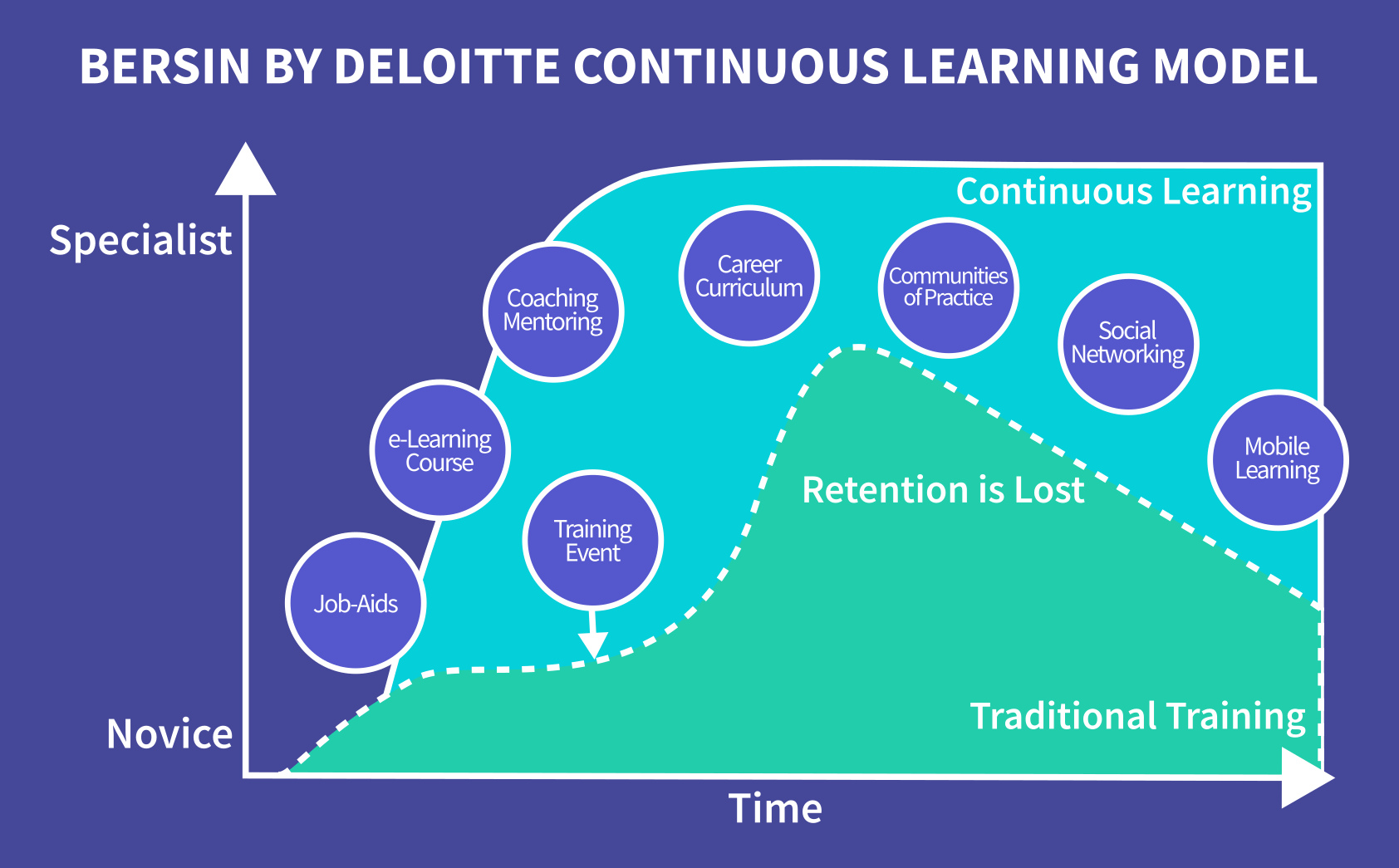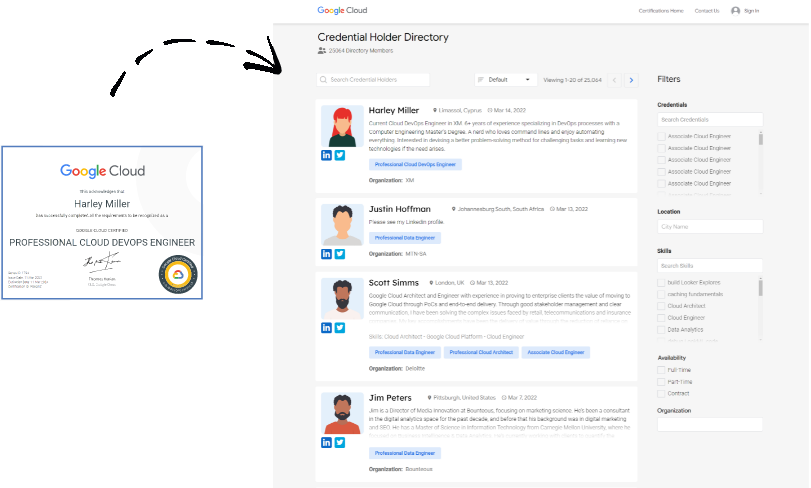According to research carried out by Citrix, the changing workforce has introduced an increased demand for continuous learning in order to remain relevant in the global job market. A reported 82% of employees and 62% of HR directors said they believe that workers will need to reskill or upskill at least once a year to maintain this competitive advantage. This has also impacted the demand for digital credentials. Over 85% of surveyed learners are looking for programs that offer digital credentials for higher education, career development, and personal development. They want portable credentials that provide a more detailed picture of their competencies and are easier to share with their networks. This post explores how organizations can use this demand to promote a culture of continuous learning and increase motivation for lifelong learning using digital credentials.
What is continuous learning?
Continuous learning, continuing education, or lifelong learning is the ongoing process of gaining new skills, knowledge, and experience for either professional or personal reasons. It can be self-directed learning through online courses, come in the form of casual social learning, take place as formal learning within an organization, or simply be a personal desire or enjoyment of constant learning.

The chart above shows that a continuous learning model not only helps students to better retain their gained knowledge through regular opportunities to learn but supports them to become specialist experts in their field of knowledge. Compared to traditional training where research suggests that up to 90% of the gained knowledge is lost within the following year when not actively applied or practiced.
What are the benefits of continuous learning?
Benefits of Continuous Learning for Individuals
Continuous learning benefits the individual in their professional life by enabling them to gain new knowledge and skills that can improve their competence and personal performance. They might choose continuous learning to support their career development by making them eligible for a promotion or enabling them to pursue a new career path. It can help professionals stay current with the latest technologies and remain marketable in evolving environments, or simply be a pursuit of personal enrichment by extending their knowledge into areas outside of their day-to-day job responsibilities.
Benefits of Continuous Learning for Organizations
For organizations, the development of a learning culture is an effective way to improve company-wide performance and innovation, and promote employee engagement. The more knowledgeable the workforce is, the more they can contribute to the growth of the organization. Organizations that invest in learning and development opportunities see better retention and satisfaction. 76% of employees say that a company would be more appealing if it offered additional skill training programs to their staff. They see this as a company willing to invest in their career development and feel more valued as a result. They are more likely to stay with the organization longer than if they were working for an organization that doesn’t provide these opportunities. Research reveals that retention rates rise by 30-50% for companies with strong learning cultures. It is also cheaper for organizations to invest in their current employees than going through the process of hiring and training new staff. The average company spends $4,000 to hire a new employee, without factoring in onboarding time.
How do digital credentials promote continuous learning?
Learner preferences are changing and issuers need to respond to the increasing demand for high-quality learning environments and experiences. Candidates are less engaged by long-form lectures, they want gamified, short-form learning opportunities that enable them to upskill or reskill faster - 67% of learners prefer gamified classes and learning experiences over traditional education methods while 83% of workers who received gamified training reported increased motivation. We live in an always-on, ‘one-click’ world and candidates no longer want to wait days or weeks for their certificates. They want to celebrate their achievements in the moment with their peers, friends, and family, and showcase their new skills on social media.
An Enhanced Learning Experience
Digital credentials enhance the learning experience by providing instantly deliverable rewards that are received by email moments after the candidate has met the target goal criteria, whether it’s achieving a passing mark on an exam, completing a module, or successfully submitting an assessment. Their digital credentials are verifiable in one-click, without the need to await a response from credentialing departments or request additional, sometimes costly, transcripts. Digital credentials can be used to gamify the learning journey through the delivery of digital badges for individual module completion leading to a final digital certificate for completing the program.


The Need for Easy to Pursue Learning
Degrees are expensive to obtain and take between 2 - 4 years to complete. They don’t fully prepare candidates for increasing job segmentation, and are often out of reach for individuals who are already in work or have family commitments. As a result, college enrollments are down by nearly a million since the start of the pandemic and by nearly 3 million over the last decade. Today’s learners are seeking affordable, targeted awards that bring value to their resume and help them to progress in their career. They want to fill the gaps in their skill set and improve their opportunities to enter specialized roles.
Accessible and Targeted Education
Digital credentials help to make education more accessible for a wider audience. With Accredible’s per-unique recipient pricing, it becomes more cost-effective for issuers to break their programs into manageable micro-learning opportunities - No matter how many credentials a recipient earns within a billing cycle, the issuer only spends 1 credit. The issuer can also offer versatile courses using the stackable micro-credentials framework that enables candidates to pursue the level of skill they need. This enables candidates to build a portfolio that accommodates a specific level of complexity in a topic or across multiple topics. For example, an individual looking to progress their competence in Microsoft Office products may need to understand the basics in Excel but need to reach an expert level of knowledge in Powerpoint. Organizations benefit from targeted training that allows their employees to put their skills into practice faster without creating wasted training spend and time as a result of broad training programs. Candidates gain access to more affordable education that enables them to learn around their life-work commitments.
How can education institutions use digital credentials to motivate continuous learning?
The first step is ensuring you own all the credentials tied to you as the issuer, so recipients know your brand conveys value. Typically, physical credentials are out of the issuer’s control once they have been received by candidates. If the issuer needs to revoke a credential, they have to trust the candidate to return or destroy their certificate. If the issued physical credential expires, they have to trust the recipient will return and update their knowledge rather than spoof or edit the expiration date, which can be easily done through photo editing programs. Physical and PDF credentials both have a low barrier to fraud which can lead to harm to the issuing organization’s reputation.
Protecting the Value of Career-Advancing Credentials
Digital credentials have a high barrier to fraud, especially blockchain certificates and badges which are effectively impossible to hack and require more computing power than is currently available in the world to make unauthorized edits. Digital credentials provide increased control. Issuers can set expiration dates on their credentials which prompts an automated email to the recipient when the credential is nearing expiration and again once the expiration date has passed. Once past the expiration date, the credential is updated with a clearly visible ‘expired’ banner and can no longer be verified. This motivates candidates to return to keep their career-advancing credentials up-to-date. Issuers can also easily revoke credentials where necessary.
Keeping the Issuer in Mind for Future Opportunities
Issuers need ways to ensure their brand remains at the forefront of their recipient’s mind when they are pursuing continuous education or looking to refresh their knowledge and skills. Accredible’s Spotlight Directory enables issuers to build a customizable, searchable hub of their certified industry experts. Being featured in an industry-leader’s directory is a career-defining event for candidates, it enables them to be found by recruiters and employers looking for certified professionals, and showcases the roles already achieved by their industry peers. With the option to exclude expired credentials, alumni have increased motivation to return and re-earn their credentials to ensure they keep their place in the directory and don’t miss out on potential career-advancing opportunities.

Increasing Visibility for Recommended Next Steps
Once a recipient has completed a course, a lack of visibility on where they should go next could mean the candidate becomes unengaged and doesn’t pursue any further programs, or starts a new learning journey with a competing certification provider. Issuers need to provide clear guidance that defines the recommended next steps for a candidate and motivates them to continue progressing in their chosen professional development pathway. Recommendations can be presented in the credential delivery email, through 1 to 1 follow-ups, on the issuer’s marketing website, or in automated email marketing campaigns to alumni.
Creating Learning Pathways through Pathways
At Accredible we provide the ability to build credential ‘Pathways’, referred to as learning pathways by other providers. Pathways enable issuers to showcase to candidates what credentials should be earned and when they should be earned. Create sequential groupings of credentials which guide recipients to the next step from the credential itself and enable the recipient to present to the rest of the world which milestone credentials they have earned from that learning pathway. For issuers that are charging on a per course basis, this helps to drive revenue by encouraging and incentivizing individuals to understand what the next step is by linking straight from the credential they’ve just received on the credential page or from the credential delivery email. Pathways is supported by analytics dashboards which enable issuers to gain insight into course enrollments, how their candidates are progressing, and completion rates.
In Summary
Digital credentials help issuers re-engage alumni and motivate continued education by meeting the changing demands of candidates for gamified learning experiences that can be undertaken around work-life commitments. The savings gained in time and spend from switching to digital credentials and per-unique recipient pricing makes it more cost-effective for issuers to break programs into manageable microlearning modules that facilitate targeted learning. The ability to automate credential issuance through integration with learning management systems (LMS) provides more time for engaging students elsewhere in their learning journey. The increased control over credential expiration and validity increase the visibility of out-of-date credentials, encouraging learners to return and refresh their skills, and helping to drive revenue and program growth.
Whether learning programs are delivered through in-person environments, online learning, or hybrid environments. Digital credentials support issuers to enhance the learning journey and motivate students to pursue continuous learning for the benefit of their professional development.
See digital credentials in action and book a platform demo today, or for a tailored pricing quotation based on your credentialing needs, reach out to request a quote.
Further Reading
Download our Increase Enrollment for Professional Certification Guide for insights and advice for organizations offering professional certification that are looking to grow their programs. In this guide explore how digital credentials increase enrollment and boost referral rates through the use of contextual data, shareability, and engagement.
Get the guide and research how to:
- Identify the demand for professional certification
- Determine what learners want from professional certification
- Increase engagement for professional certification programs
- Utilize digital credential recipients to boost referral rates








